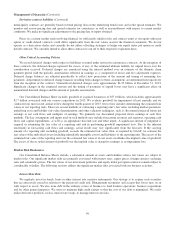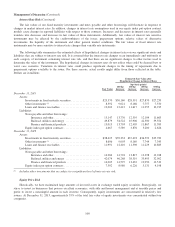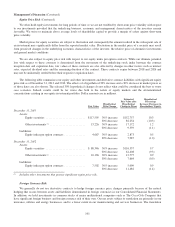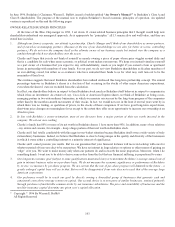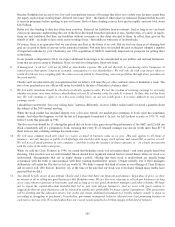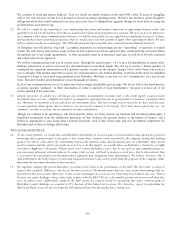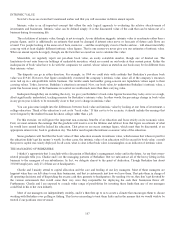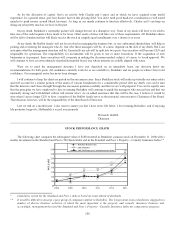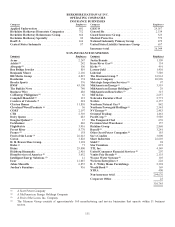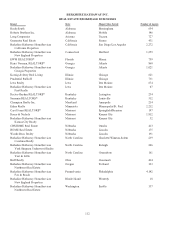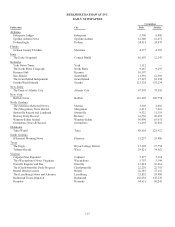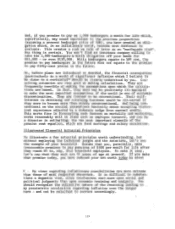Berkshire Hathaway 2013 Annual Report Download - page 111
Download and view the complete annual report
Please find page 111 of the 2013 Berkshire Hathaway annual report below. You can navigate through the pages in the report by either clicking on the pages listed below, or by using the keyword search tool below to find specific information within the annual report.
BERKSHIRE HATHAWAY INC.
INTRINSIC VALUE – TODAY AND TOMORROW *
Though Berkshire’s intrinsic value cannot be precisely calculated, two of its three key pillars can be measured. Charlie
and I rely heavily on these measurements when we make our own estimates of Berkshire’s value.
The first component of value is our investments: stocks, bonds and cash equivalents. At yearend these totaled
$158 billion at market value.
Insurance float – money we temporarily hold in our insurance operations that does not belong to us – funds $66 billion
of our investments. This float is “free” as long as insurance underwriting breaks even, meaning that the premiums we receive equal
the losses and expenses we incur. Of course, underwriting results are volatile, swinging erratically between profits and losses. Over
our entire history, though, we’ve been significantly profitable, and I also expect us to average breakeven results or better in the future.
If we do that, all of our investments – those funded both by float and by retained earnings – can be viewed as an element of value for
Berkshire shareholders.
Berkshire’s second component of value is earnings that come from sources other than investments and insurance
underwriting. These earnings are delivered by our 68 non-insurance companies, itemized on page 106. In Berkshire’s early years, we
focused on the investment side. During the past two decades, however, we’ve increasingly emphasized the development of earnings
from non-insurance businesses, a practice that will continue.
The following tables illustrate this shift. In the first table, we present per-share investments at decade intervals
beginning in 1970, three years after we entered the insurance business. We exclude those investments applicable to minority interests.
Yearend
Per-Share
Investments Period
Compounded Annual Increase
in Per-Share Investments
1970 ...................... $ 66
1980 ...................... 754 1970-1980 27.5%
1990 ...................... 7,798 1980-1990 26.3%
2000 ...................... 50,229 1990-2000 20.5%
2010 ...................... 94,730 2000-2010 6.6%
Though our compounded annual increase in per-share investments was a healthy 19.9% over the 40-year period, our
rate of increase has slowed sharply as we have focused on using funds to buy operating businesses.
The payoff from this shift is shown in the following table, which illustrates how earnings of our non-insurance
businesses have increased, again on a per-share basis and after applicable minority interests.
Year
Per-Share
Pre-Tax Earnings Period
Compounded Annual Increase in
Per-Share Pre-Tax Earnings
1970 ................... $ 2.87
1980 ................... 19.01 1970-1980 20.8%
1990 ................... 102.58 1980-1990 18.4%
2000 ................... 918.66 1990-2000 24.5%
2010 ................... 5,926.04 2000-2010 20.5%
For the forty years, our compounded annual gain in pre-tax, non-insurance earnings per share is 21.0%. During the
same period, Berkshire’s stock price increased at a rate of 22.1% annually. Over time, you can expect our stock price to move in
rough tandem with Berkshire’s investments and earnings. Market price and intrinsic value often follow very different paths –
sometimes for extended periods – but eventually they meet.
There is a third, more subjective, element to an intrinsic value calculation that can be either positive or negative: the
efficacy with which retained earnings will be deployed in the future. We, as well as many other businesses, are likely to retain
earnings over the next decade that will equal, or even exceed, the capital we presently employ. Some companies will turn these
retained dollars into fifty-cent pieces, others into two-dollar bills.
*Reproduced from Berkshire Hathaway Inc. 2010 Annual Report.
109


